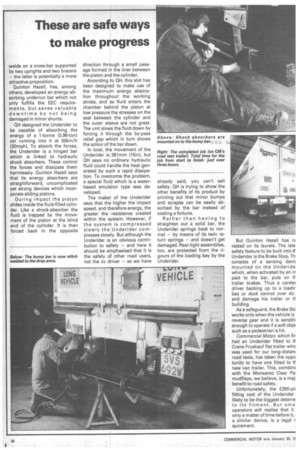These are safe ways to make progress
Page 34

If you've noticed an error in this article please click here to report it so we can fix it.
welds on a cross-bar supported by two uprights and two bracers — the latter is potentially a more attractive proposition.
Quinton Hazel], has, among others, developed an energy absorbing underrun bar which not only fulfills the EEC requirements, but saves valuable downtime by not being damaged in minor shunts.
QH designed the Underider to be capable of absorbing the energy of a 1-tonne (0.98-ton) car running into it at 50km/h (30mph). To absorb the forces, the Underider is a hinged bar which is linked to hydraulic shock absorbers. These control the forces and dissipate them harmlessly. Quinton Hazell says that its energy absorbers are straightforward, uncomplicated yet strong devices which incorporate sliding pistons.
During impact the piston slides inside the fluid-filled cylinder. Like a shock-absorber the fluid is trapped by the movement of the piston at the blind end of the cylinder. It is then forced back in the opposite direction thrOugh a small passage formed in the liner between the piston and the cylinder.
According to QH, this slot has been designed to make use of the maximum energy absorption throughout the working stroke, and as fluid enters the chamber behind the piston at low pressure the stresses on the seal between the cylinder and the outer sleeve are not great. The unit slows the fluid down by forcing it though the by-pass relief gap which in turn shows the action of the bar down.
In total, the movement of the Underider is 381mm (15in), but QH says no ordinary hydraulic fluid could handle the heat generated by st.ich a rapid dissipation. To overcome the problem, a special fluid which is a waterbased emulsion type was de
veloped. I
The maker of the Underider says that the higher the impact speed, and therefore energy, the greater the resistance created within the system. However, if the system is compressed slowly the Underider compresses slowly. But although the Underider is an obvious contribution to safety — and here it should be emphasised that it is the safety of other road users, not the cv driver — as we have
already said, you can't sell safety. QH is trying to show the other benefits of its product by printing out that minor bumps and scrapes can be easily absorbed by the bar instead of costing a fortune.
Rather than having to straighten out a solid bar, the Underider springs back to normal — by means of its twin return springs — and doesn't get damaged. Rear-light assemblies, too, are protected from the rigours of the loading bay by the Underider.
But Quinton Hazell has ni rested on its laurels. The late safety feature to be built into tr Underider is the Brake Stop. Th consists of a sensing devic mounted on the Underide which, when activated by an in pact to the bar, puts on ft trailer brakes. Thus a carele: driver backing up to a loadir bay or dock cannot over do and damage his trailer or tlbuilding.
As a safeguard, the Brake Stc works only when the vehicle is reverse gear and it is sensitiN enough to operate if a soft obje such as a pedestrian is hit.
Commercial Motor, which fir had an Underider fitted to Crane Fruehauf flat trailer whic was used for our long-distanc road tests, has taken the oppc tunity to have one fitted to if new van trailer. This, combinE with the Monsanto Clear Pa: mudflaps, we believe, is a maj, benefit to road safety.
Unfortunately, the £260-ph fitting cost of the Underider likely to be the biggest deterre to its fitment. But sma operators will realise that it only a matter of time before it, a similar device, is a legal r quirement.
























































